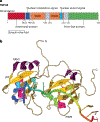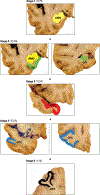Limbic-predominant age-related TDP43 encephalopathy (LATE) neuropathological change in neurodegenerative diseases
- PMID: 37563264
- PMCID: PMC10964248
- DOI: 10.1038/s41582-023-00846-7
Limbic-predominant age-related TDP43 encephalopathy (LATE) neuropathological change in neurodegenerative diseases
Abstract
TAR DNA-binding protein 43 (TDP43) is a focus of research in late-onset dementias. TDP43 pathology in the brain was initially identified in amyotrophic lateral sclerosis and frontotemporal lobar degeneration, and later in Alzheimer disease (AD), other neurodegenerative diseases and ageing. Limbic-predominant age-related TDP43 encephalopathy (LATE), recognized as a clinical entity in 2019, is characterized by amnestic dementia resembling AD dementia and occurring most commonly in adults over 80 years of age. Neuropathological findings in LATE, referred to as LATE neuropathological change (LATE-NC), consist of neuronal and glial cytoplasmic TDP43 localized predominantly in limbic areas with or without coexisting hippocampal sclerosis and/or AD neuropathological change and without frontotemporal lobar degeneration or amyotrophic lateral sclerosis pathology. LATE-NC is frequently associated with one or more coexisting pathologies, mainly AD neuropathological change. The focus of this Review is the pathology, genetic risk factors and nature of the cognitive impairments and dementia in pure LATE-NC and in LATE-NC associated with coexisting pathologies. As the clinical and cognitive profile of LATE is currently not easily distinguishable from AD dementia, it is important to develop biomarkers to aid in the diagnosis of this condition in the clinic. The pathogenesis of LATE-NC should be a focus of future research to form the basis for the development of preventive and therapeutic strategies.
© 2023. Springer Nature Limited.
Conflict of interest statement
Competing interests
The authors declare no competing interests.
Figures




References
-
- Arai T et al. TDP-43 is a component of ubiquitin-positive tau-negative inclusions in frontotemporal lobar degeneration and amyotrophic lateral sclerosis. Biochem. Biophys. Res. Commun 351, 602–611 (2006). - PubMed
-
- Neumann M et al. Ubiquitinated TDP-43 in frontotemporal lobar degeneration and amyotrophic lateral sclerosis. Science 314, 130–133 (2006). - PubMed
-
- Brenowitz WD, Monsell SE, Schmitt FA, Kukull WA & Nelson PT Hippocampal sclerosis of aging is a key Alzheimer’s disease mimic: clinical-pathologic correlations and comparisons with both Alzheimer’s disease and non-tauopathic frontotemporal lobar degeneration. J. Alzheimers Dis 39, 691–702 (2014). - PMC - PubMed
Publication types
MeSH terms
Substances
Supplementary concepts
Grants and funding
LinkOut - more resources
Full Text Sources
Medical
Research Materials

